CHEVROLET VENTURE 2003 1.G Manual PDF
Manufacturer: CHEVROLET, Model Year: 2003, Model line: VENTURE, Model: CHEVROLET VENTURE 2003 1.GPages: 486, PDF Size: 3.3 MB
Page 71 of 486
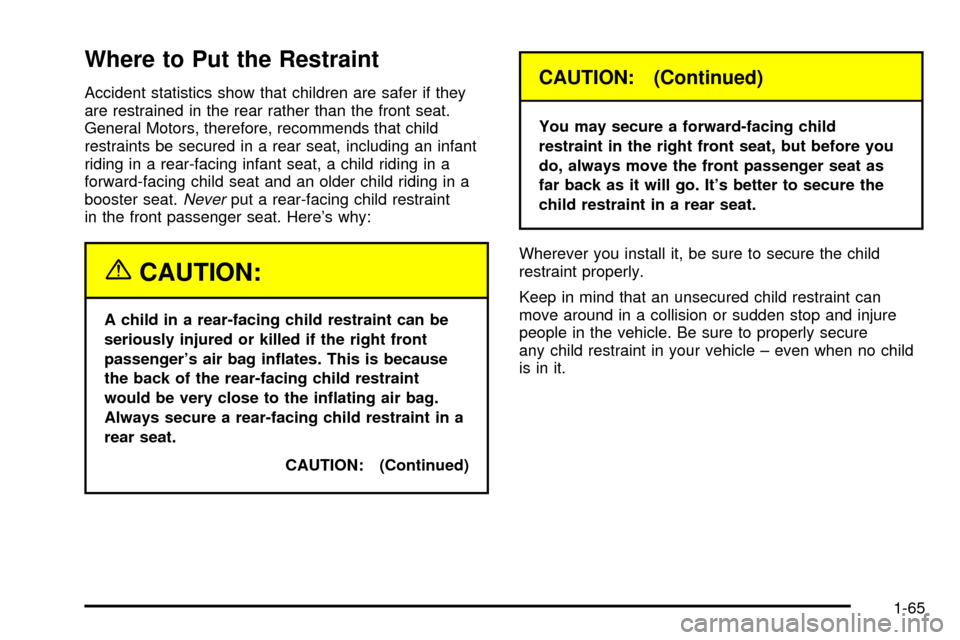
Where to Put the Restraint
Accident statistics show that children are safer if they
are restrained in the rear rather than the front seat.
General Motors, therefore, recommends that child
restraints be secured in a rear seat, including an infant
riding in a rear-facing infant seat, a child riding in a
forward-facing child seat and an older child riding in a
booster seat.
Neverput a rear-facing child restraint
in the front passenger seat. Here's why:
{CAUTION:
A child in a rear-facing child restraint can be
seriously injured or killed if the right front
passenger's air bag in¯ates. This is because
the back of the rear-facing child restraint
would be very close to the in¯ating air bag.
Always secure a rear-facing child restraint in a
rear seat.
CAUTION: (Continued)
CAUTION: (Continued)
You may secure a forward-facing child
restraint in the right front seat, but before you
do, always move the front passenger seat as
far back as it will go. It's better to secure the
child restraint in a rear seat.
Wherever you install it, be sure to secure the child
restraint properly.
Keep in mind that an unsecured child restraint can
move around in a collision or sudden stop and injure
people in the vehicle. Be sure to properly secure
any child restraint in your vehicle ± even when no child
is in it.
1-65
Page 72 of 486
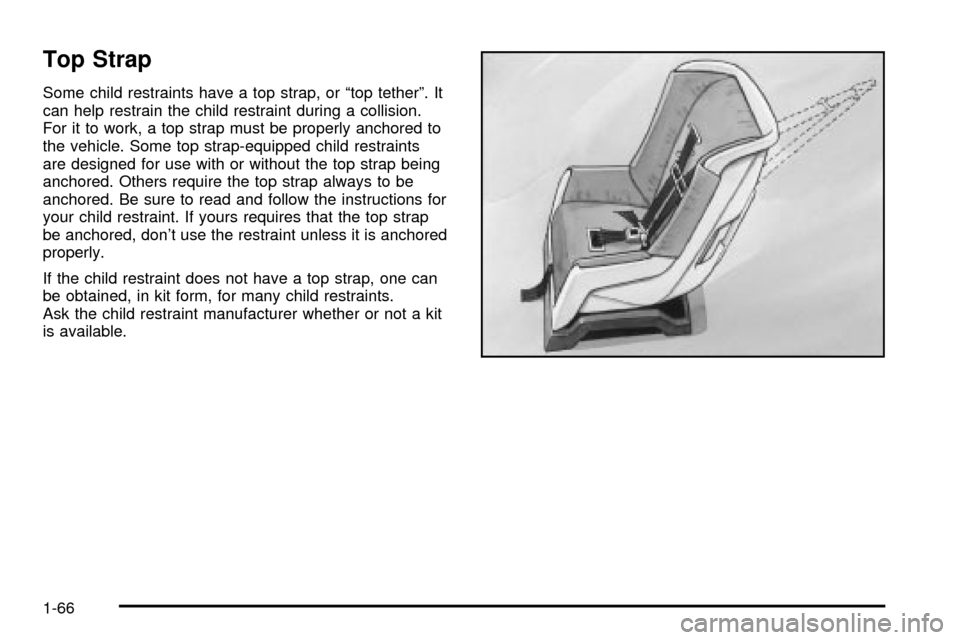
Top Strap
Some child restraints have a top strap, or ªtop tetherº. It
can help restrain the child restraint during a collision.
For it to work, a top strap must be properly anchored to
the vehicle. Some top strap-equipped child restraints
are designed for use with or without the top strap being
anchored. Others require the top strap always to be
anchored. Be sure to read and follow the instructions for
your child restraint. If yours requires that the top strap
be anchored, don't use the restraint unless it is anchored
properly.
If the child restraint does not have a top strap, one can
be obtained, in kit form, for many child restraints.
Ask the child restraint manufacturer whether or not a kit
is available.
1-66
Page 73 of 486
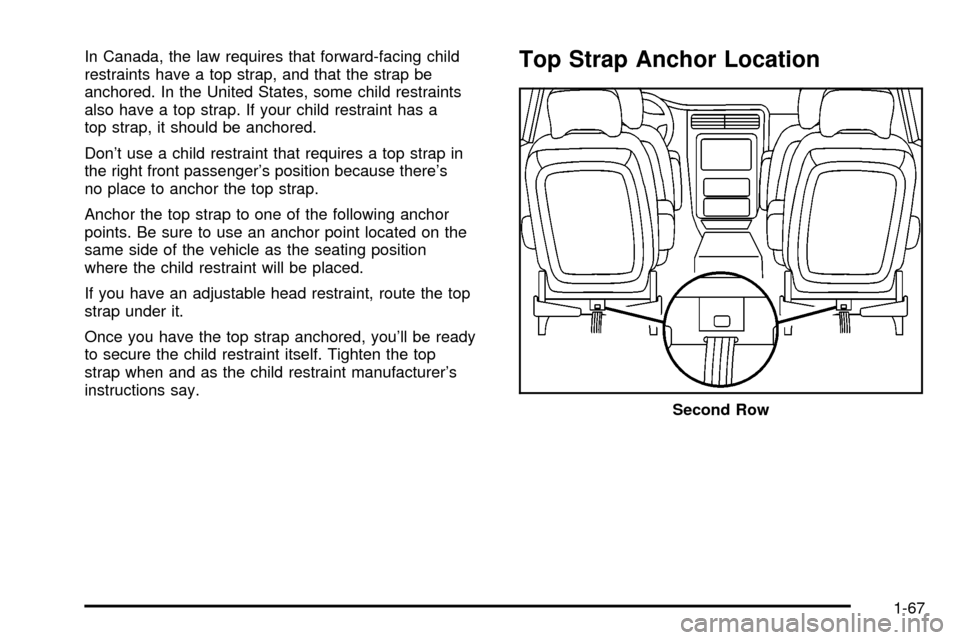
In Canada, the law requires that forward-facing child
restraints have a top strap, and that the strap be
anchored. In the United States, some child restraints
also have a top strap. If your child restraint has a
top strap, it should be anchored.
Don't use a child restraint that requires a top strap in
the right front passenger's position because there's
no place to anchor the top strap.
Anchor the top strap to one of the following anchor
points. Be sure to use an anchor point located on the
same side of the vehicle as the seating position
where the child restraint will be placed.
If you have an adjustable head restraint, route the top
strap under it.
Once you have the top strap anchored, you'll be ready
to secure the child restraint itself. Tighten the top
strap when and as the child restraint manufacturer's
instructions say.Top Strap Anchor Location
Second Row
1-67
Page 74 of 486
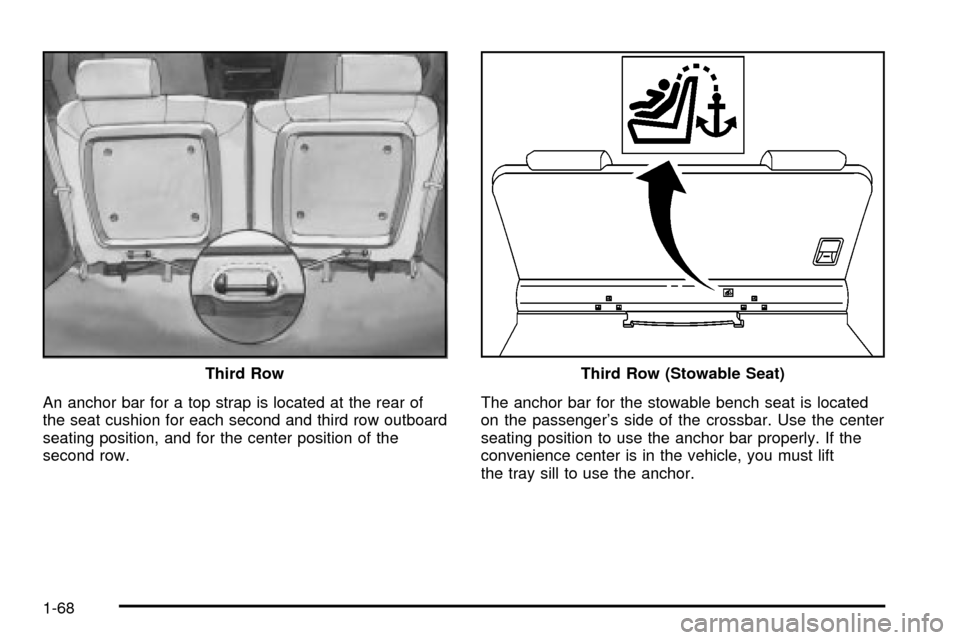
An anchor bar for a top strap is located at the rear of
the seat cushion for each second and third row outboard
seating position, and for the center position of the
second row.The anchor bar for the stowable bench seat is located
on the passenger's side of the crossbar. Use the center
seating position to use the anchor bar properly. If the
convenience center is in the vehicle, you must lift
the tray sill to use the anchor. Third Row
Third Row (Stowable Seat)
1-68
Page 75 of 486
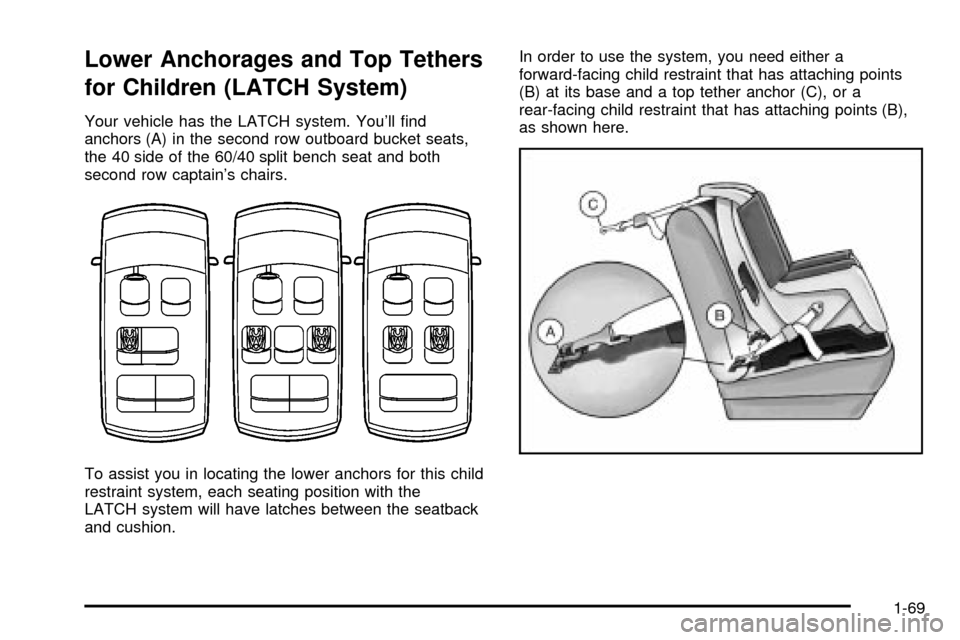
Lower Anchorages and Top Tethers
for Children (LATCH System)
Your vehicle has the LATCH system. You'll ®nd
anchors (A) in the second row outboard bucket seats,
the 40 side of the 60/40 split bench seat and both
second row captain's chairs.
To assist you in locating the lower anchors for this child
restraint system, each seating position with the
LATCH system will have latches between the seatback
and cushion.In order to use the system, you need either a
forward-facing child restraint that has attaching points
(B) at its base and a top tether anchor (C), or a
rear-facing child restraint that has attaching points (B),
as shown here.
1-69
Page 76 of 486
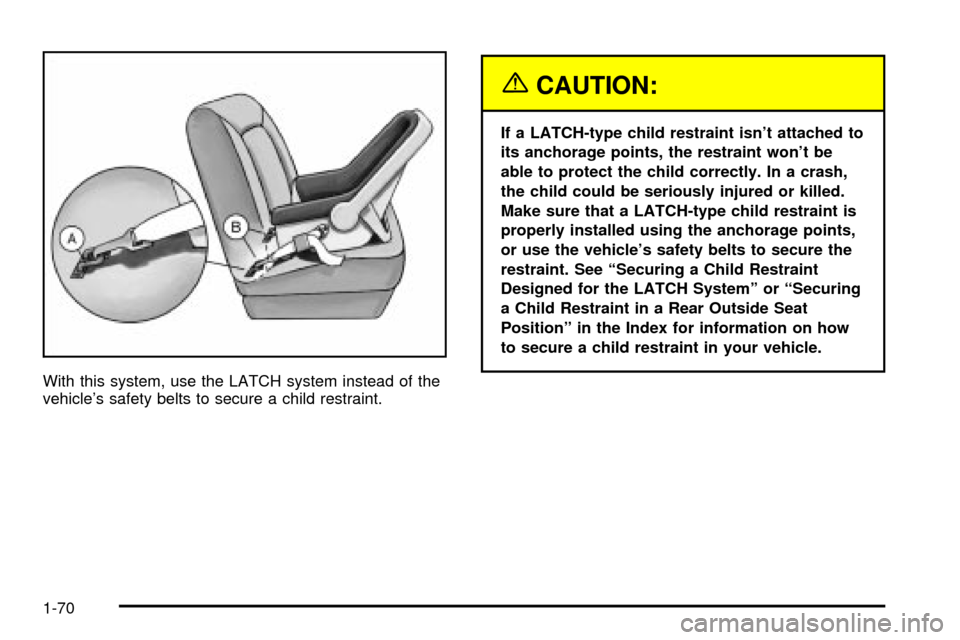
With this system, use the LATCH system instead of the
vehicle's safety belts to secure a child restraint.
{CAUTION:
If a LATCH-type child restraint isn't attached to
its anchorage points, the restraint won't be
able to protect the child correctly. In a crash,
the child could be seriously injured or killed.
Make sure that a LATCH-type child restraint is
properly installed using the anchorage points,
or use the vehicle's safety belts to secure the
restraint. See ªSecuring a Child Restraint
Designed for the LATCH Systemº or ªSecuring
a Child Restraint in a Rear Outside Seat
Positionº in the Index for information on how
to secure a child restraint in your vehicle.
1-70
Page 77 of 486
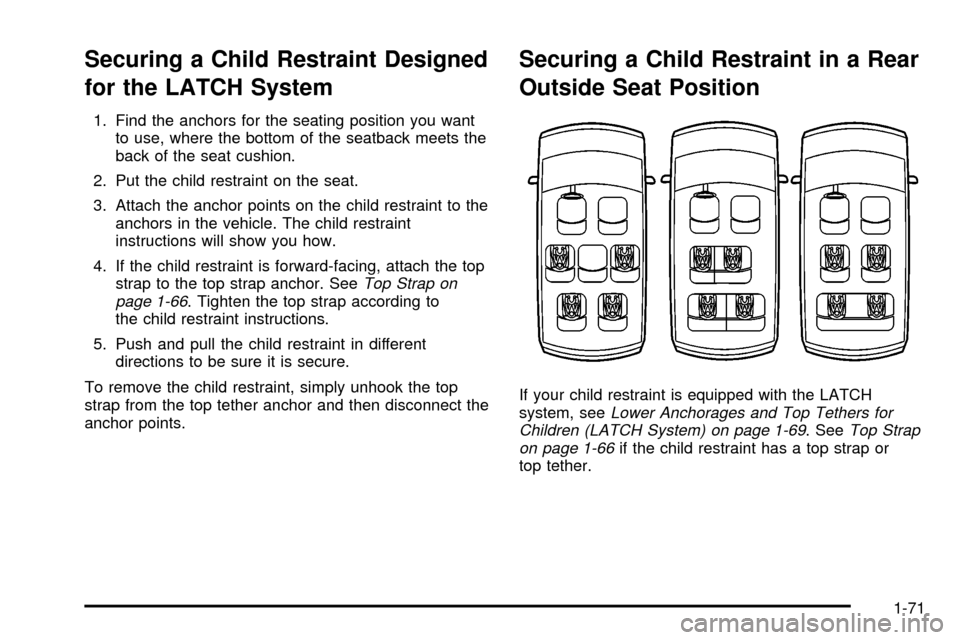
Securing a Child Restraint Designed
for the LATCH System
1. Find the anchors for the seating position you want
to use, where the bottom of the seatback meets the
back of the seat cushion.
2. Put the child restraint on the seat.
3. Attach the anchor points on the child restraint to the
anchors in the vehicle. The child restraint
instructions will show you how.
4. If the child restraint is forward-facing, attach the top
strap to the top strap anchor. See
Top Strap on
page 1-66. Tighten the top strap according to
the child restraint instructions.
5. Push and pull the child restraint in different
directions to be sure it is secure.
To remove the child restraint, simply unhook the top
strap from the top tether anchor and then disconnect the
anchor points.
Securing a Child Restraint in a Rear
Outside Seat Position
If your child restraint is equipped with the LATCH
system, seeLower Anchorages and Top Tethers for
Children (LATCH System) on page 1-69. SeeTop Strap
on page 1-66if the child restraint has a top strap or
top tether.
1-71
Page 78 of 486
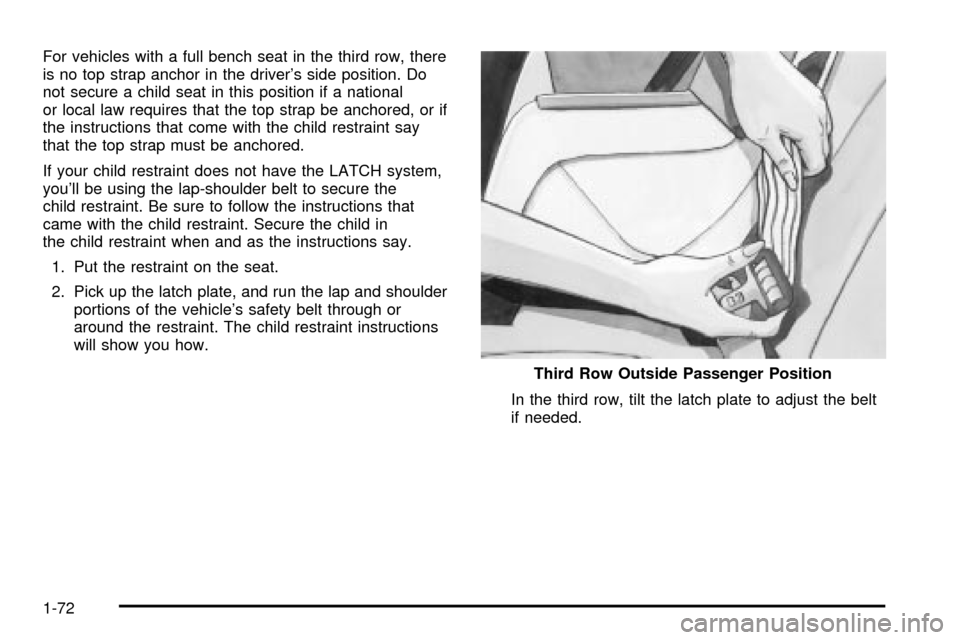
For vehicles with a full bench seat in the third row, there
is no top strap anchor in the driver's side position. Do
not secure a child seat in this position if a national
or local law requires that the top strap be anchored, or if
the instructions that come with the child restraint say
that the top strap must be anchored.
If your child restraint does not have the LATCH system,
you'll be using the lap-shoulder belt to secure the
child restraint. Be sure to follow the instructions that
came with the child restraint. Secure the child in
the child restraint when and as the instructions say.
1. Put the restraint on the seat.
2. Pick up the latch plate, and run the lap and shoulder
portions of the vehicle's safety belt through or
around the restraint. The child restraint instructions
will show you how.
In the third row, tilt the latch plate to adjust the belt
if needed.Third Row Outside Passenger Position
1-72
Page 79 of 486
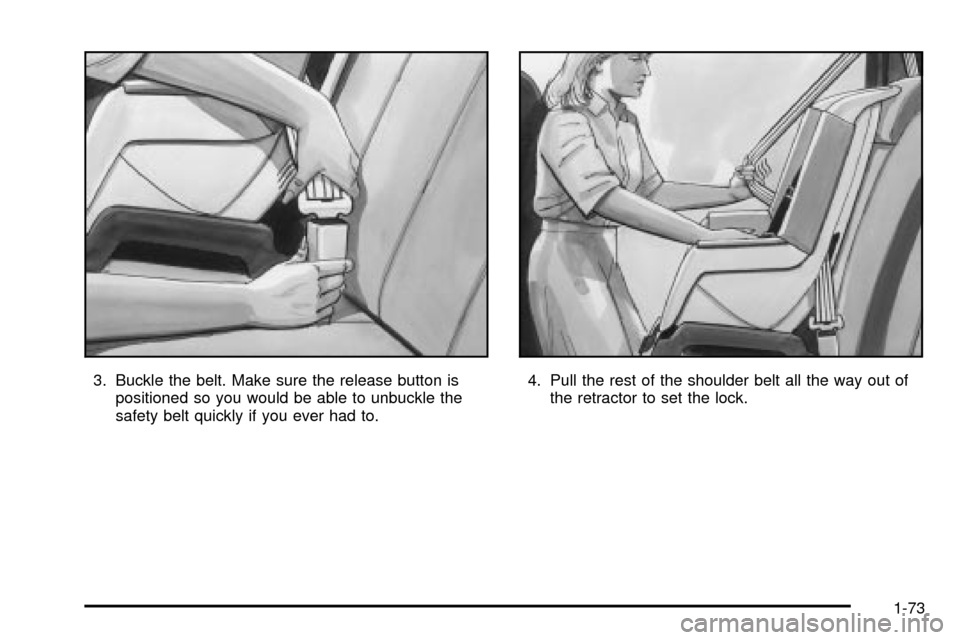
3. Buckle the belt. Make sure the release button is
positioned so you would be able to unbuckle the
safety belt quickly if you ever had to.4. Pull the rest of the shoulder belt all the way out of
the retractor to set the lock.
1-73
Page 80 of 486
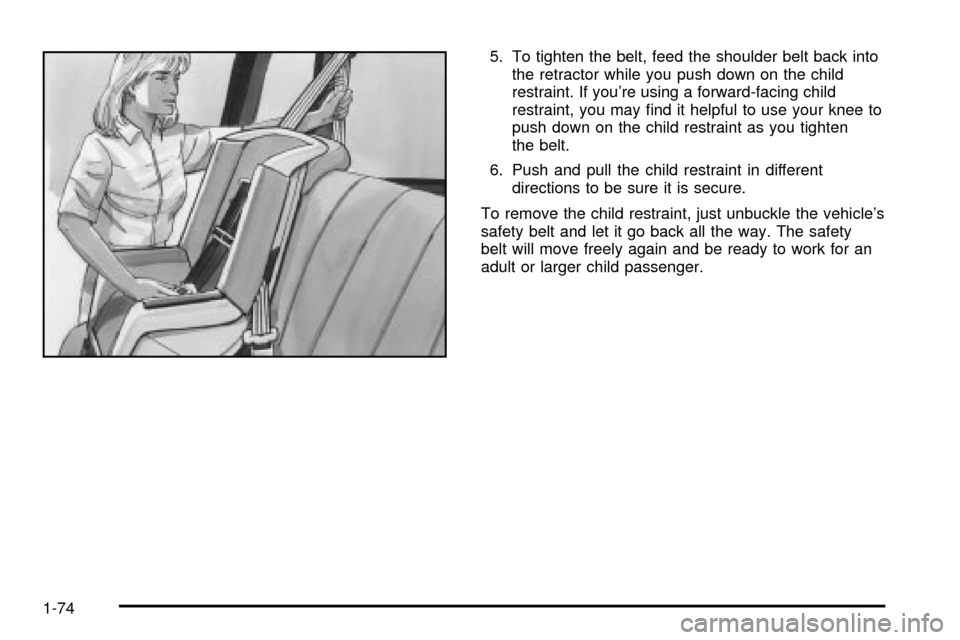
5. To tighten the belt, feed the shoulder belt back into
the retractor while you push down on the child
restraint. If you're using a forward-facing child
restraint, you may ®nd it helpful to use your knee to
push down on the child restraint as you tighten
the belt.
6. Push and pull the child restraint in different
directions to be sure it is secure.
To remove the child restraint, just unbuckle the vehicle's
safety belt and let it go back all the way. The safety
belt will move freely again and be ready to work for an
adult or larger child passenger.
1-74